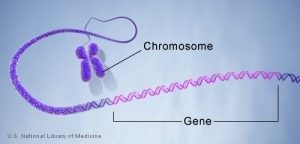Each cell in the human body has approximately 25,000 to 35,000 genes. A gene as the basic physical and functional unit of heredity consists of a sequence (a string) of bases. Gene is made up of combinations of A, T, C, and G. that determine the gene’s function. Genes, which are made up of DNA, act as instructions to make molecules called proteins. In humans, genes vary in size from a few hundred DNA bases to more than 2 million bases. In other words, the code, or blueprint in DNA is used to synthesize a protein. Also, the difference in size of genes are due to the sizes of the proteins for which they code.
The purpose of gene is to store information and besides carry the information that determines your traits. For instance, if both of your parents have blue eyes, you might inherit the trait for blue eyes from them. Or if your father has freckles, you might have freckles too because you inherited the trait for freckles. In fact, genes aren’t just found in humans — all animals and plants have genes, too. Further, every person has two copies of each gene, one inherited from each parent. Most genes are the same in all people, but a small number of genes (less than 1 percent of the total) are slightly different between people. Alleles are forms of the same gene with small differences in their sequence of DNA bases. These small differences contribute to each person’s unique physical features.

Each chromosome contains many genes. Also, each gene includes the information required to build particular proteins needed in an organism. chromosome is made of a very long strand of DNA and consists of many genes (hundreds to thousands). The genes on each chromosome have a specific sequence, each gene has a specific location on the chromosome. Besides DNA, chromosomes contain other chemical components which influence gene function.
